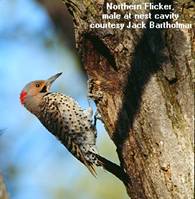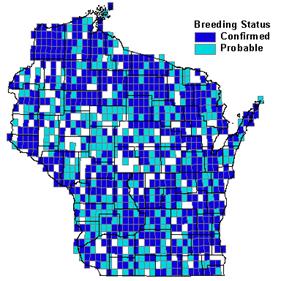Photo by Jack Bartholmai


Status/Protection
- Global Rank: G5 Key to global and state ranks
- State Rank: S5B
- WBCI Priority: PIF
Population Information
Federal BBS information can be obtained at http://www.mbr-pwrc.usgs.gov/bbs/bbs.html by clicking on Trend Estimates and selecting the species in question. All estimates are for 1966-2005.
- Federal Breeding Bird Survey: significant decline
- Federal Breeding Bird Survey (WI): significant decline
- Federal Breeding Bird Survey (BCR 23): significant decline
- Federal Breeding Bird Survey (BCR 12): significant decline
- WSO Checklist Project: declining (1983-2007)
Life History
- Breeding Range: Throughout Canada and the U.S. south to Mexico and Central America (Moore 1995).
- Breeding Habitat: Central Hardwoods, Bottomland Hardwoods, Swamp Hardwoods, Shrub-Carr, Oak, Oak Opening, Pine Barrens, Sand Barrens, Red Pine, Jack Pine, dry regenerating forest with available cavities.
- Nest: Cavity, 1.5 - 9 meters above ground.
- Nesting Dates: EGGS: early-May to mid-June (Lukes 2006).
- Foraging: Ground glean, hawks, bark glean (Ehrlich et al. 1988).
- Migrant Status: Short-distance migrant.
- Habitat use during Migration: Edges of forests, open woodlands (Moore 1995), fields (Terres 1980).
- Arrival Dates: Late March to early May (Robbins 1991).
- Departure Dates: Early September to late October (Robbins 1991).
- Winter Range: For the Yellow-shafted subspecies of the Northern Flicker, the winter range is the southeastern United States, with a variable northern edge to the wintering range. A few birds winter in Wisconsin each year, but the majority of the Wisconsin population is migratory (Moore 1995).
- Winter Habitat: Same as breeding habitat (Moore 1995).
Habitat Selection
The Northern Flicker inhabits open, dry habitats adjacent to or within forested stands with cavity trees. It is commonly found in recently cut or burned areas, provided scattered snags remain (Moore 1995). The Northern Flicker excavates cavities in dead trees or dead limbs of live trees. The height of cavities above ground varies from 1.5 to 9 meters (Robbins 1991). Nest trees vary in diameter from ~35 to 50 cm, sometimes larger (Moore 1995). The availability of nearby anthills is an important habitat characteristic. Elchuk and Wiebe (2002) found flickers were very selective of foraging locations, with the density of anthills strongly correlated to foraging areas. In fall and winter, various fruits become more important (Moore 1995).
Habitat Availability
There is abundant habitat available in Wisconsin for the Northern Flicker, which uses a wide variety of forest types and tree species. However, declining availability of suitable nest-cavity substrates may be limiting the Northern Flicker populations in certain areas (Moore 1995).
Population Concerns
Northern Flickers are broadly distributed throughout the state of Wisconsin and are common breeders. During the six-year period (1995-2000) of the Wisconsin Breeding Bird Atlas, observers confirmed breeding activity in 50% of the surveyed quads and in every county (Lukes 2006). However, Breeding Bird Survey data suggest significant declines range-wide and in Wisconsin for this species (Sauer et al. 2005). The loss of snags and dead limbs used for nest cavities may be the primary factor in its population decline. Competition with other cavity-nesting species, such as European Starlings, also may be a factor.
Recommended Management
Management efforts for this species should focus on snag retention in public and private lands (Moore 1995). Efforts should be made to inform individual homeowners and homeowner associations about the importance of snags and provide guidelines on snag retention. Results from one urban study suggest conserving all snags that are large in diameter (minimum of 30-40 cm), more decayed, taller (>18 m), with broken tops, and with some bark remaining (Blewett and Marzluff 2005). Preserving trees with existing cavities or areas with high densities of existing snags should be a high conservation priority.
Research Needs
Additional research is needed to determine the extent that reduced cavity-availability is limiting Northern Flicker populations (Moore 1995). Further research is needed on nest-site competition between the European Starling and the Northern Flicker. Studies that investigate snag densities, snag characteristics, and their link to cavity-nesting birds in urban areas are warranted and may help to guide urban snag policies (Blewett and Marzluff 2005).
Information Sources
- Chequamegon National Forest Bird Survey (NRRI) species account: http://www.nrri.umn.edu/mnbirds/accounts/YSFLa2.htm
- Nicolet NF bird survey map: http://www.uwgb.edu/birds/nnf/species/YSFL.htm
- North American Breeding Bird Survey: http://www.npwrc.usgs.gov
- Temple S.A., J.R. Cary, and R. Rolley. 1997. Wisconsin Birds: A Seasonal and Geographical Guide. Wisconsin Society of Ornithology and Wisconsin Department of Natural Resources, Madison, WI.
- Wisconsin Breeding Bird Atlas: www.uwgb.edu/birds/wbba/
References
- Blewett, C.M. and J.M. Marzluff. 2005. Effects of urban sprawl on snags and the abundance and productivity of cavity-nesting birds. Condor 107:678-693.
- Ehrlich, P.R., D.S. Dobkin, and D. Wheye. 1988. The birders handbook: a field guide to the natural history of North American birds. Simon & Schuster, Inc. New York.
- Elchuk, C.A., and K.L. Wiebe. 2002. Food and predation risk as factors related to foraging locations of Northern Flickers. Wilson Bull. 114(3):349-357.
- Lukes, R. 2006. Northern Flicker. In Atlas of the Breeding Birds of Wisconsin. (N.J. Cutright, B.R. Harriman, and R.W. Howe, eds.) The Wisconsin Society for Ornithology, Inc. 602pp.
- Moore, W.S. 1995. Northern Flicker (Colaptes auratus), In The Birds of North America, No. 166 (A. Poole and F. Gill, eds.). Academy of Natural Sciences, Philadelphia, PA, and the American Ornithologists’ Union, Washington, D.C.
Robbins, S.D. 1991. Wisconsin birdlife: population & distribution, past & present. Univ. of Wisconsin Press, Madison, WI. - Temple, S.A., J.R. Cary, and R. Rolley. 1997. Wisconsin birds: a seasonal and geographical guide. Second edition. Univ. of Wisconsin Press, Madison, WI.
- Terres, J. K. 1980. The Audubon Society Encyclopedia of North American Birds. Alfred Knopf, New York.
Contact Information
- Compiler: William P. Mueller, iltlawas@earthlink.net
- Editors: Bruce Bacon, Bruce.Bacon@Wisconsin.gov | Kim Kreitinger, K.Kreitinger@gmail.com
